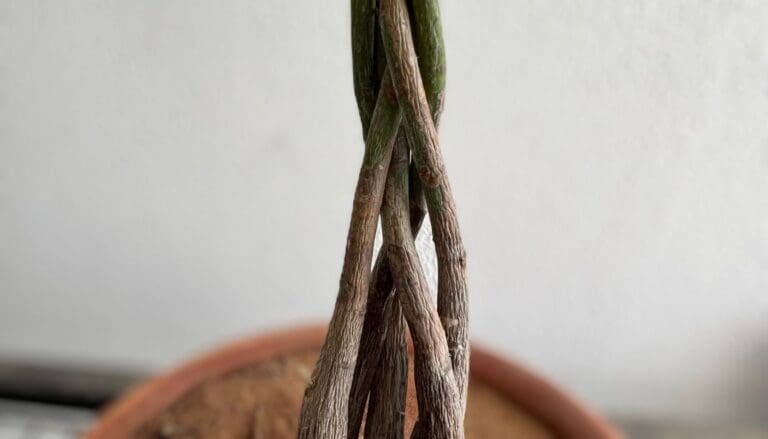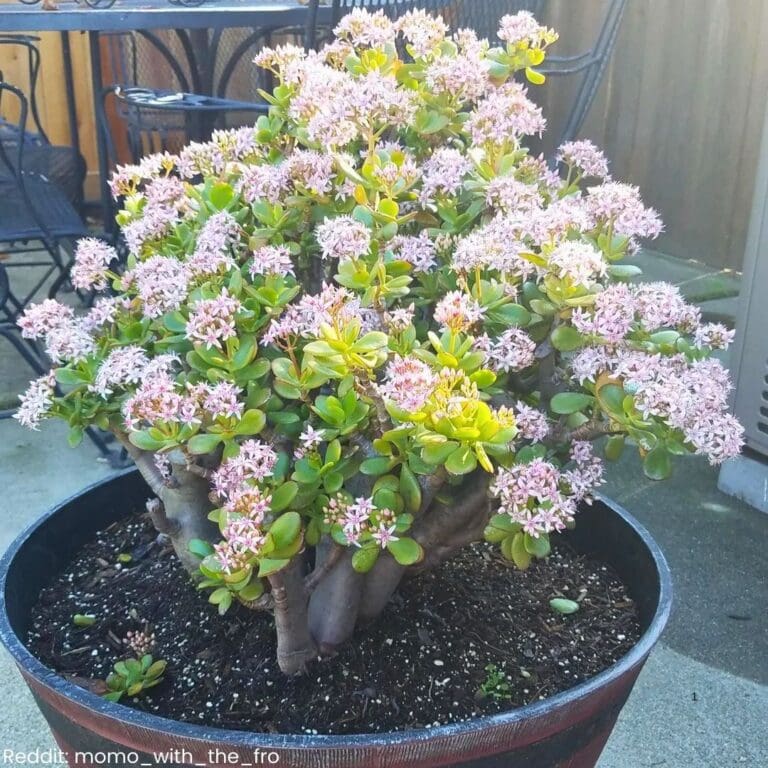What Kind Of Pot For Croton? (Pot Size, Material & More)
Crotons are hardy and colorful plants that come from tropical regions. They have gained popularity as houseplants because of their stunning leaves. But as a houseplant, your Croton will not thrive without a suitable pot.
Let’s find out what kind of pot is good for croton?
In general, glazed ceramic and plastic pots will be ideal for crotons as these materials can keep the soil evenly moist. You can also use terracotta pots to allow proper airflow into the roots. Choose a 1-2 inch bigger pot than the current one and make sure it has enough drainage holes.
Whichever pot you choose for your Croton, ensure proper drainage holes and the correct size.
Let’s look at all the available pots that you can use for your Croton and consider their advantages and disadvantages.

Please note: Simplify Plants is reader-supported. Some links in the post are affiliate links and I get a commission from purchases made through links in the post.
How to choose the right pot for Crotons?
Crotons are tropical plants that enjoy moisture but don’t appreciate too much of it. You should select a pot after keeping that in mind.
You should remember some factors before selecting the right pot for your Croton. These are:
- Drainage holes
- Size of the pot
- Material of the pot
- Cleaning the pot
Let’s discuss each factor to determine the best pot for your Croton.
Drainage holes
Drainage holes are essential for every plant. Why? Without drainage holes, the excess water will have no way of getting out of the pot.
The soil will keep holding the excess water and make the roots of your Croton wet that might cause root rot and other problems such as pest infestations.
Although Crotons love moisture, they will not tolerate excess water, and to avoid all overwatering issues, you must use a pot with drainage holes.
If the pot you bought doesn’t come with drainage holes, drill one or more using a drilling machine before putting the Croton inside it.
What size pot does a croton need?
The size of the pot is not insignificant and plays a vital role in determining the health of your Croton.
When repotting a Croton, select a pot that is only one size larger than its present pot. And if you are getting a Croton for the first time, select a pot that is one size bigger than the plant.
If you choose a too-small pot, your Croton will become rootbound.
In a smaller pot, the roots will lack space to grow freely. They will start forming clusters and replacing the soil. This will make the plant weak.
If the Croton plant is bigger than its pot, the pot might break due to the pressure from the roots, or the plant can fall over due to being top-heavy.
On the other hand, if you choose a bigger pot, your Croton might get overwatered. How?
A big pot will require more soil, and more soil will hold more water. The plant might not require as much water, so it will not absorb all of it, and the excess water will remain in the soil.
This excess water will keep the roots wet for longer, creating an overwatering situation.
Therefore, you can understand the importance of choosing the right size pot for your Croton. The pot’s diameter should be at least 1-2 inches bigger than the Croton roots.
With the right-sized pot, the roots of your Croton will be able to breathe and function at their optimum levels.
Cleaning the pot
Before we discuss the material of the pot, let’s discuss cleaning. You will need to keep the pot of your Croton clean to avoid fungal growth and other issues that can affect the plant’s health.
If you don’t have much time to clean, you can opt for a plastic or ceramic pot that is easier to clean than terracotta or wooden pots.
You can use bleach to clean the terracotta pots. You can wipe the plastic pots with a wet wipe soaked in soapy water, rinse them with regular water, and let them dry before keeping the plant inside it again.
Material of the pot
Now let’s discuss the most interesting factor: the pot’s material. There are different kinds of materials available in the market, and you might want to choose one that will match the aesthetics you want to create.
Choosing any material is fine as long as you know how to take care of the Croton in that pot. Since Croton is a tropical plant, it will prefer growing in evenly moist soil easily attainable in plastic and unglazed ceramic pots.
But you can also choose any other pot material after knowing the pros and cons, of course.
Plastic pot
Although I don’t recommend plastic pots, these are the most common type of pot available these days. Plastic pots have gained popularity due to the easy maintenance and the variety they provide.
Advantages:
- Plastic pots are easy to carry from one place to another as they are lightweight.
- Since plastic doesn’t break easily, you can move it around quickly and keep it anywhere in the house.
- Plastic pots come in different shapes, designs, and varieties.
- Plastic pots are affordable.
Disadvantages:
- Plastic pots retain a lot of moisture and make the soil soggy if the drainage system is not good enough.
- The color of plastic pots fades when placed under direct or too much sunlight.
- Plastic pots don’t support proper airflow into the soil and roots of the plant.
Ceramic pot
You can find ceramic pots both in glazed and unglazed forms. These give an attractive look to the space, and therefore many people prefer this material.
Advantages:
- Ceramic pots are great for tropical plants like Crotons that require moist soil.
- Ceramic pots don’t break as easily as terracotta pots.
- Ceramic pots are heavy and keep the plant stable.
- The soil will retain moisture more than a terracotta pot.
Disadvantages:
- Ceramic pots are heavier than plastic pots, so you might have difficulty moving the plant from one place to another when it grows big.
- Many fancy ceramic pots don’t have drainage holes, so you will need to drill holes under the pot before placing the Croton inside.
Terracotta pot
If you want the roots to have proper airflow and enough oxygen to breathe, you must go for a terracotta pot. This is porous and found in many gardens and window sills.
Advantages:
- Terracotta pots keep the Croton stable as they are pretty heavy.
- Terracotta pots are porous, promoting airflow in the soil and roots.
- Terracotta pots are found in both affordable and expensive ranges.
- Since terracotta pots are porous, the soil dries out faster than other pots.
Disadvantages:
- Terracotta pots are heavy and not easy to move around unless you use rollers.
- Due to their clay base, terracotta pots can break easily if you drop them.
- Water will dry out faster in terracotta pots, so you will need to provide frequent watering to your Croton when it is placed in a terracotta pot.
Fiberglass pot
Fiberglass pots are loved for their durability and cost. These have become popular lately, and you’ll notice them in many houses.
Advantages:
- Fiberglass pots are durable.
- Fiberglass pots don’t get rust or cracks.
- Fiberglass pot is lightweight and easy to move around.
- Fiberglass pots are available in attractive shapes and designs.
Disadvantages:
- Fiberglass pots are non-porous. If you don’t provide water properly, your Croton can get overwatered.
- Fiberglass pots are costlier than plastic pots.
- Fiberglass pots can heat the soil on hot days.
Wooden pot
If you want to opt for natural and organic containers for your plants, you can choose wooden pots. These bring a different aesthetic look to the garden and indoors.
Advantages:
- Wooden pot can retain moisture well, which is suitable for Crotons.
- Wooden pot is lightweight than ceramic or terracotta pots.
- A wooden pot will last long.
- A wooden pot can bring a different look to the space.
- You can use recycled wooden boxes as planters for your Croton and other houseplants.
Disadvantages:
- Wood is porous. Therefore the soil will dry out faster, and the Croton will need more water.
- Cleaning a wooden pot can be harder than cleaning other materials.
- Water can leak from wooden pots. So you can keep a tray beneath the pot.
Metal pot
Metal pots give the plant a unique and beautiful look and your indoor space. You can recycle any metal container you might have and use it as a planter for your Croton.
Advantages:
- You can recycle the metal containers you have and use those as pots for your houseplants.
- Metal pots can last for many years.
- Metal pots are hard to break.
Disadvantages:
- Metal pots can become hot when exposed to intense sunlight.
- Metal pots will be more suitable for succulents and not tropical plants.
- Metal pots are non-porous, so you need to water the plant carefully to avoid overwatering.
- Metal pots can develop rust.
Final words
You can use any pot for your Croton, depending on the type of look you want to achieve with the plant and its pot. You must remember that you need to take care of the plant according to its pot.
If you keep your Croton in a plastic pot, the soil will take more time to dry out than a Croton kept in a terracotta pot. So you need to adjust the watering accordingly. However, you must not skip having drainage holes and choosing the correct sized pot to maintain the health of your Croton.
Along with the suitable pot, provide the ideal growing conditions to find your Croton thriving.
Reference: Sciencedirect, Wikipedia, Wikipedia, Britannica, CABI, Academia, University of South Florida, The University of Georgia.
Recommended Garden Supplies
| Product Image | Our Recommended Gardening Supplies | Check Offers! |
|---|---|---|
Top Top
Top
Top
Top
Top
Top
Top
Top | rePotme Houseplant and Tropical Classic Potting Soil Mix | Check Offer On Amazon |
 Top
Top
Top
Top
Top
Top
Top
Top | Espoma Organic Indoor Plant Food | Check Offer On Amazon |
 Top
Top
Top
Top
Top
Top
Top
Top | GooingTop LED Grow Light 6000K Full Spectrum Clip Plant Growing Lamp | Check Offer On Amazon |
 Top
Top
Top
Top
Top
Top
Top
Top | Soil Moisture Meter | Check Offer On Amazon |
 Top
Top
Top
Top
Top
Top
Top
Top | Govee Hygrometer Thermometer, Bluetooth Enabled! | Check Offer On Amazon |
 Top
Top | LEVOIT Humidifiers for Large Room(Best For Plants) | Check Offer On Amazon |
 Top
Top
Top
Top
Top
Top
Top
Top | Upgraded DIY Automatic Drip Irrigation Kit, 15 Potted Houseplants Support | Check Offer On Amazon |
 Top
Top
Top
Top
Top
Top
Top
Top | Stainless Steel Heavy Duty Gardening Tool Set | Check Offer On Amazon |
 Top
Top
Top
Top
Top
Top
Top
Top | Bonide Insecticidal Soap | Check Offer On Amazon |
 Top
Top
Top
Top
Top
Top
Top
Top | Bonide 32 oz Spray Neem Oil for Organic Gardening | Check Offer On Amazon |
 Top
Top
Top
Top
Top
Top
Top
Top | Garden Safe Fungicide | Check Offer On Amazon |












